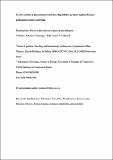Por favor, use este identificador para citar o enlazar a este item:
http://hdl.handle.net/10261/115358COMPARTIR / EXPORTAR:
 SHARE SHARE
 CORE
BASE CORE
BASE
|
|
| Visualizar otros formatos: MARC | Dublin Core | RDF | ORE | MODS | METS | DIDL | DATACITE | |

| Título: | In vitro activity of Glucosinolates and their degradation products against Brassica-pathogenic bacteria and fungi |
Autor: | Sotelo Pérez, Tamara CSIC; Lema Márquez, Margarita CSIC ORCID; Soengas Fernández, María del Pilar; Cartea González, María Elena CSIC ORCID; Velasco Pazos, Pablo CSIC ORCID | Palabras clave: | Xanthomonas Alternaria Sclerotinia Pseudomonas Brassica rapa Brassica oleracea Brassica napus Secondary metabolites Glucosinolates |
Fecha de publicación: | ene-2015 | Editor: | American Society for Microbiology | Citación: | Applied and Environmental Microbiology 81 (1): 432- 440 (2015) | Resumen: | Glucosinolates (GSLs) are secondary metabolites found in Brassica vegetables that confer on them resistance against pests and diseases. Both GSLs and glucosinolate hydrolysis products (GHPs) have shown positive effects in reducing soil pathogens. Information about their in vitro biocide effects is scarce, but previous studies have shown sinigrin GSLs and their associated allyl isothiocyanate (AITC) to be soil biocides. The objective of this work was to evaluate the biocide effects of 17 GSLs and GHPs and of leaf methanolic extracts of different GSL-enriched Brassica crops on suppressing in vitro growth of two bacterial (Xanthomonas campestris pv. campestris and Pseudomonas syringae pv. maculicola) and two fungal (Alternaria brassicae and Sclerotinia scletoriorum) Brassica pathogens. GSLs, GHPs, and methanolic leaf extracts inhibited the development of the pathogens tested compared to the control, and the effect was dose dependent. Furthermore, the biocide effects of the different compounds studied were dependent on the species and race of the pathogen. These results indicate that GSLs and their GHPs, as well as extracts of different Brassica species, have potential to inhibit pathogen growth and offer new opportunities to study the use of Brassica crops in biofumigation for the control of multiple diseases. | Versión del editor: | http://dx.doi.org/10.1128/AEM.03142-14 | URI: | http://hdl.handle.net/10261/115358 | DOI: | 10.1128/AEM.03142-14 | ISSN: | 0099-2240 | E-ISSN: | 1098-5336 |
| Aparece en las colecciones: | (MBG) Artículos |
Ficheros en este ítem:
| Fichero | Descripción | Tamaño | Formato | |
|---|---|---|---|---|
| Sotelo_In_vitro...pdf | 150,43 kB | Adobe PDF |  Visualizar/Abrir |
CORE Recommender
PubMed Central
Citations
32
checked on 26-mar-2024
SCOPUSTM
Citations
89
checked on 17-abr-2024
WEB OF SCIENCETM
Citations
84
checked on 24-feb-2024
Page view(s)
395
checked on 18-abr-2024
Download(s)
262
checked on 18-abr-2024
Google ScholarTM
Check
Altmetric
Altmetric
Artículos relacionados:
NOTA: Los ítems de Digital.CSIC están protegidos por copyright, con todos los derechos reservados, a menos que se indique lo contrario.
